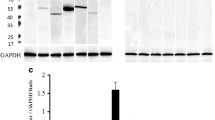Summary
The uptake of L-dopa into the cells of the adenohypophysis of the rat was studied during the postnatal development and at adult age using the formaldehyde-induced fluorescence method (FIF). The cells taking up L-dopa were classified by Alcian blue-PAS-Orange G staining. The correlation between the cells taking up L-dopa and those containing tryptophyl-peptide was estimated during the postnatal period and in adult rats. The cells containing tryptophyl-peptide were demonstrated using fluorescence induced by treatment with combined formaldehyde and acetyl chloride vapour.
The following observations were made: 1) Great majority of the cells taking up L-dopa did not contain tryptophyl-peptide. Thus the accumulation of L-dopa into the cells of pars distalis is not due to accumulation of L-dopa into the cells by the same transport mechanism as the amino acids for tryptophyl-peptide. 2) Of the cells taking up L-dopa in the adult rats 96% were chromophobes, 2.0% acidophilic cells (somatotrophs and cells producing prolactin), 0.9% R-mucoid cells (corticotrophs), and 1.2% S1- and S2-mucoid cells (gonadotrophs and thyrotrophs). At 10 and 25 days' age the relative numbers of the cells taking up L-dopa were about the same. 3) Pretreatment with nialamide caused only a slight increase in the number of the cells taking up L-dopa. The decrease in the number of the cells uptaking L-dopa of the pars distalis, which takes place after 5 weeks' age is thus not caused by the increased MAO-activity. 4) Strongly chromophilic cells did not take up L-dopa.
At the light of our results it seems evident that L-dopa is taken up by the chromophobic cells when these differentiate into chromophilic cells. The accumulation of L-dopa may be a sign of an active transport of amino acids into the cells. The accumulation of L-dopa into the chromophobic stellate and follicular cells may reflect their metabolic activity. These cells probably have an important role in the production of the hormones of the pars distalis.
Similar content being viewed by others
References
Adams, C. W. M., Swettenham, K. V.: The histochemical identification of two types of basophil cells in the normal human adenohypophysis. J. Path. Bact. 75, 95–103 (1958)
Björklund, A., Falck, B.: Histochemical characterization of a tryptamine-like substance stored in cells of the mammalian adenohypophysis. Acta physiol. scand. 77, 475–489 (1969)
Dahlström, A., Fuxe, K.: Monoamines and the pituitary gland. Acta endocr. (Kbh.) 51, 301–314 (1966)
Eränkö, O.: Distribution of fluorescing islets, adrenaline and noradrenaline in the adrenal medulla of the hamster. Acta endocr. (Kbh.) 18, 174–179 (1955)
Eränkö, O.: The practical histochemical demonstration of catecholamines by formaldehyde-induced fluorescence. J. roy. micr. Soc. 87, 259–276 (1967)
Gershon, M. D., Ross, L. L.: Radioisotopic studies of the binding, exchange, and distribution of 5-hydroxytryptamine synthesized from its radioactive precursor. J. Physiol. (Lond.) 186, 451–476 (1966)
Håkanson, R., Larsson, L.-I., Nobin, A., Sundler, F.: Tryptamine or tryptophyl peptides in endocrine cells of the mammalian adenohypophysis ? J. Histochem. Cytochem. 20, 908–916 (1972)
Hyyppä, M., Wurtman, R. J.: Biogenic amines in the pituitary gland: What is their origin and function ? Pituitary indolamines. In: Drug effects on neuroendocrine regulation (eds. Zimmermann et al.). Progr. Brain Res. 39, 211–215 (1973)
Leleux, P., Robyn, C.: Immunohistochemistry of individual adenohypophysial cells. Acta endocr. (Kbh.) 67, Suppl. 153, 168–189 (1971)
Partanen, S., Rechardt, L.: Histochemically demonstrable monoamines in the pituitary gland and median eminence of the female rat during the postnatal development. Z. Zellforsch. 147, 41–57 (1973)
Partanen, S., Rechardt, L., Bäck, N.: Combined formaldehyde and acetyl chloride vapour condensation: A new fluorescence histochemical method for the demonstration of tryptophyl-peptide-containing endocrine cells of the hypophysis. Histochemistry, in press (1974)
Pearse, A. G. E.: 5-Hydroxytryptophan uptake by dog thyroid C cells, and its possible significance in polypeptide hormone production. Nature (Lond.) 211, 598–600 (1966)
Pearse, A. G. E.: Histochemistry. Theoretical and applied, vol. 1, third ed. London: J. & A. Churchill Ltd. 1968
Pearse, A. G. E.: The cytochemistry and ultrastructure of polypeptide hormone-producing cells of the APUD series and the embryologic, physiologic and pathologic implications of the concept. J. Histochem. Cytochem. 17, 303–313 (1969)
Pearse, A. G. E., MacGregor, M. M.: Functional cytology of the pituitary gland. Ann. Rep. Brit. Emp. Cancer Camp. 2, 665–666 (1964)
Pearse, A. G. E., Noorden, S. van: The functional cytology of the human adenohypophysis. Canad. med. Ass. J. 88, 462–471 (1963)
Pearse, A. G. E., Polak, J. M.: Endocrine tumours of neural crest origin: Neurolophomas, apudomas and the APUD concept. Med. Biol. 52, 3–18 (1974)
Pearse, A. G. E., Polak, J. M., Rost, F. W. D., Fontaine, J., Le Lièvre, C., Le Douarin, N.: Demonstration of the neural crest origin of type I (APUD) cells in the avian carotid body, using a cytochemical marker system. Histochemie 34, 191–203 (1973)
Siperstein, E., Nichols, C. W., Jr., Griesbach, W. E., Chaikoff, I. L.: Cytological changes in the rat anterior pituitary from birth to maturity. Anat. Rec. 118, 593–619 (1954)
Solcia, E., Vasallo, G., Capella, C.: Selective staining of endocrine cells by basic dyes after acid hydrolysis. Stain Technol. 43, 257–263 (1968)
Takor Takor, T., Pearse, A. G. E.: Cytochemical identification of human and murine pituitary corticotrophs and somatotrophs as APUD cells. Histochemie 37, 207–214 (1973)
Vanha-Perttula, T.: Esterases of the rat adenohypophysis. Acta physiol. scand. 69, Suppl. 283, 1–104 (1966)
Vila-Porcile, E.: Le réseau des cellules folliculo-stellaires et les follicules de l'adénohypophyse du rat (Pars distalis). Z. Zellforsch. 129, 328–369 (1972)
Author information
Authors and Affiliations
Rights and permissions
About this article
Cite this article
Partanen, S., Rechardt, L. & Bäck, N. Histochemical observations on uptake of L-dopa into endocrine cells of the rat pituitary gland during the postnatal development. Cell Tissue Res. 156, 451–461 (1975). https://doi.org/10.1007/BF00225105
Received:
Issue Date:
DOI: https://doi.org/10.1007/BF00225105




